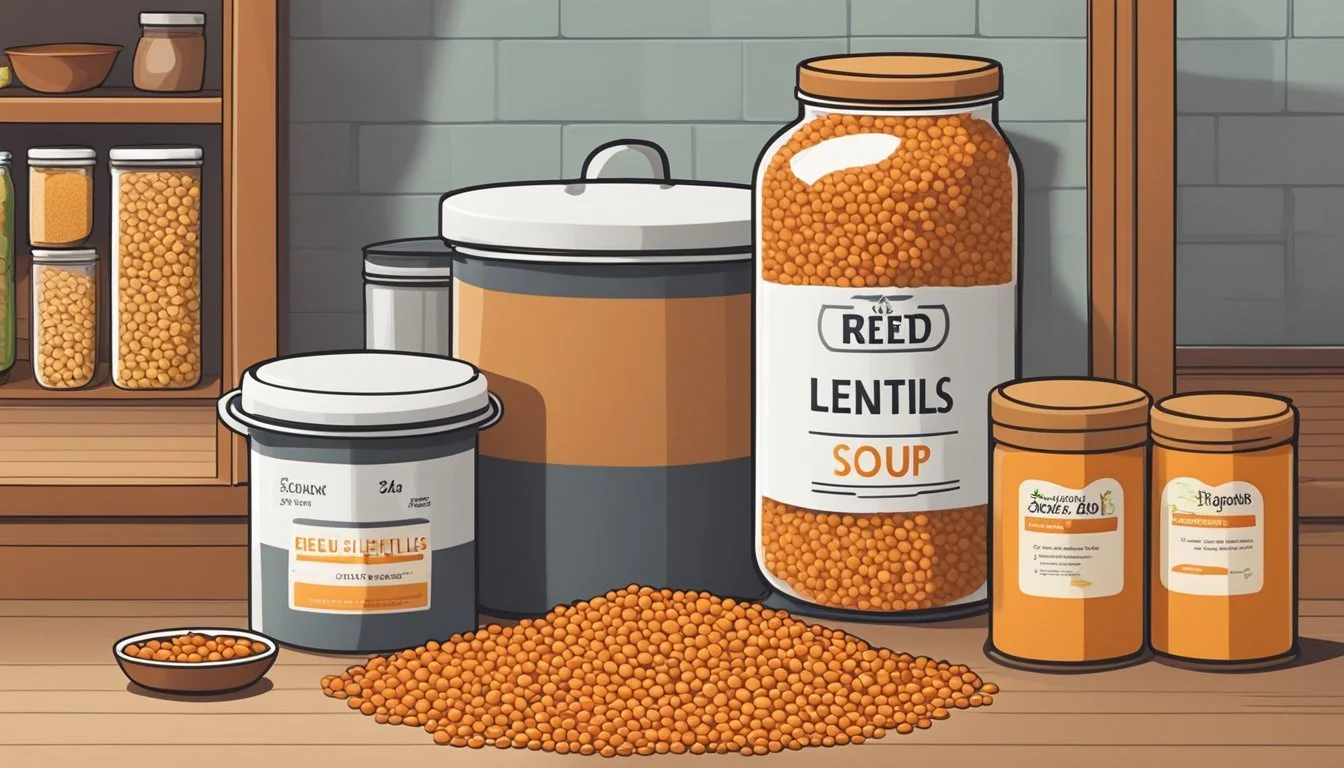How to Substitute Red Lentils for Brown Lentils in Soups
A Simple Guide
Red lentils are a staple in many kitchens, praised for their quick cooking time and ability to thicken soups (What wine goes well with soups?) to a perfect consistency. However, there are occasions when red lentils may not be available or when a different texture or flavor is desired. This is where brown lentils come into play. They are an excellent candidate for substitution, offering a robust, earthy taste and maintaining their shape well during cooking, which brings a hearty presence to any soup.
When substituting brown lentils in recipes that originally call for red lentils, there are a few considerations to ensure the success of the dish. Brown lentils take longer to cook than red lentils, so the cooking time must be adjusted accordingly. Additionally, because they don't break down as much as red lentils, the final texture of the soup will be more defined and less creamy. This difference can be advantageous depending on the desired outcome of the recipe.
Understanding the unique characteristics and cooking requirements of brown lentils enables cooks to make informed decisions when using them as substitutes. It is important to account for their varied cooking times, textural contributions, and flavor profiles. Adapting recipes to incorporate brown lentils can lead to delicious variations on classic soups, expanding culinary options and overcoming ingredient limitations with ease.
Understanding Lentils
Lentils are an essential ingredient in many dishes, offering a wide range of textures and flavors as well as significant nutritional benefits. They are a staple in plant-based diets due to their high protein content.
Nutritional Profile of Lentils
Lentils are a powerhouse of nutrition, providing a rich source of protein which is crucial for muscle repair and growth. They are also high in dietary fiber, supporting digestive health and assisting in controlling blood sugar levels. Lentils contain vital minerals such as iron and magnesium and are a significant source of potassium and zinc. Additionally, they are rich in folate, which is important for DNA synthesis and repair.
Key Nutrients in Lentils:
Protein: essential for bodily functions and muscle health
Fiber: beneficial for digestion and glycemic control
Iron: vital for oxygen transportation in the blood
Potassium: helps manage blood pressure levels
Folate: crucial for cell division and DNA formation
Types of Lentils and Their Characteristics
Lentils come in a variety of colors and sizes, each type distinct in its culinary use and flavor profile:
Brown Lentils: They are versatile and hold their shape well, with an earthy flavor. Common in Western cuisine.
Red Lentils: Often found in Middle Eastern and Indian dishes, these lentils cook quickly to a creamy texture.
Green Lentils: These maintain a firm texture and offer a peppery taste, ideal for salads.
French Lentils (Puy Lentils): They are small, have a firm texture with a nutty flavor, and come from the Puy region in France.
Beluga Lentils: Named for their caviar-like appearance, they are black in color and have a robust, earthy flavor.
Yellow Lentils: Common in soup recipes, they have a sweet, nutty flavor and turn creamy when cooked.
Cooking Times and Textures
The cooking time and the resulting texture of lentils can vary significantly between types:
Brown Lentils: Generally cook in about 20-30 minutes and stay intact, lending a tender texture to dishes.
Red Lentils: Typically cook within 15-20 minutes and break down easily, creating a creamy consistency in soups and purees.
French and Green Lentils: Require longer cooking times, approximately 25-35 minutes, but retain a firmer texture, which is perfect for salads and side dishes.
Black Lentils (Beluga): They need around 25-30 minutes and hold their shape well, offering a meaty bite.
The versatility and varying cooking qualities of lentils make them a fantastic substitute for one another in soups, given the chef's awareness of their distinct characteristics and culinary applications.
Preparation for Substitution
When substituting red lentils for brown lentils in soups, one must consider the differences in cooking time, texture, and flavor. Ensuring a seamless substitution requires attention to liquid ratios, cooking techniques, and flavor profiles.
Adjusting Liquid Ratios
Red lentils absorb less liquid than brown lentils and also cook to a softer texture. To compensate, reduce the amount of liquid—such as water or broth—by approximately 10-15%. This adjustment helps maintain the expected consistency of the soup. A starting guideline is as follows:
Brown Lentils: 3 cups of liquid per 1 cup of lentils
Red Lentils (as substitute): 2.5 to 2.7 cups of liquid per 1 cup of lentils
Modifying Cooking Techniques
Brown lentils hold their shape after cooking, while red lentils break down more easily. It is advisable to shorten the cooking time for red lentils to avoid over-softening, particularly if the original recipe uses a longer simmering time for brown lentils. Use a Dutch oven or similar heavy pot for even heat distribution and monitor the lentils frequently:
Cooking Time for Brown Lentils: 30-40 minutes
Cooking Time for Red Lentils: 15-20 minutes
Balancing Flavors and Spices
Red lentils have a milder and slightly sweet taste, so when substituting for the more earthy-flavored brown lentils, one might need to adjust the spices. Amplify the earthy flavor with a bit more cumin or coriander, and consider bold flavorful spices like paprika to match the flavor profile. Incorporate fresh herbs such as parsley or cilantro, and a squeeze of lemon juice for brightness near the end of cooking.
Spices for Brown Lentils: Earthy, robust (cumin, coriander, paprika)
Spices for Red Lentils: Adjust quantities slightly to match desired flavor
Choosing Complementary Vegetables
Opt for vegetables that complement the softer texture of red lentils. Vegetables like carrots, celery (how long does celery last?), and spinach can be added later in the cooking process to avoid overcooking. Sauteing common soup bases like onion and garlic at the start remains crucial for a flavorful base, while quick-cooking vegetables like peas and spinach should be added shortly before the soup is finished to retain their color and texture.
Vegetables: Saute onions and garlic, add carrots and celery midway, incorporate spinach or peas near the end
Lentil Soup Specifics
When considering substitution in lentil soups, it's important to understand how red lentils can alter the soup's profile in terms of texture and flavor compared to brown lentils.
A Basic Red Lentil Soup Recipe
To begin substituting red lentils for brown ones in soups, one should start with a simple red lentil soup. The basic ingredients often include:
1 tablespoon of olive oil
1 diced onion
2 cloves of garlic, minced
1 cup of red lentils
4 cups of vegetable broth
2 bay leaves
1 teaspoon of ground cumin
Kosher salt and pepper to taste
The method is straightforward. Heat the olive oil, then cook the onion and garlic until soft. Add in the lentils, broth, bay leaves, and cumin. Simmer until lentils are tender, seasoning with salt and pepper.
Incorporating Red Lentils into Existing Recipes
One can seamlessly integrate red lentils into recipes calling for brown lentils. Red lentils cook faster and break down, creating a different texture. Because they have a mild, slightly sweet flavor, they blend well into various soup recipes without dominating other flavors. To substitute red lentils for brown:
Use a 1:1 ratio when swapping lentils.
Reduce cooking time, as red lentils become tender more rapidly.
Adjust the liquid volume if necessary, since red lentils tend to thicken soups more.
Customizing Soup Thickness and Texture
Red lentils are known for their ability to create a naturally creamy texture without the need for cream or thickeners. For those desiring a chunkier soup, one might consider only partially blending the soup with an immersion blender or leaving it unblended altogether. The cooking duration also determines the final texture: a longer simmer results in a thicker soup. To tweak the texture:
For thicker soup, simmer uncovered, allowing the liquid to reduce.
For smoother soup, use an immersion blender until the desired consistency is reached.
For lighter soup, add more broth to dilute the thickness.
Additional Uses for Red Lentils
The versatility of red lentils extends far beyond soups. They can be seamlessly integrated into a variety of dishes, from hearty stews to refreshing salads and complementary grain pairings, delivering not only a boost of protein but also a creamy texture and a subtle, nutty flavor.
Beyond Soups: Stews and Side Dishes
Red lentils make an excellent thickening agent for stews due to their tendency to break down during cooking. This characteristic allows them to meld flavors and add a creamy consistency without altering the taste significantly. As a side dish, they can be prepared similarly to a pilaf, seasoned with a blend of spices such as cumin, coriander, and turmeric for a flavorful and nutritious accompaniment to a meal.
Salads and Cold Dishes with Red Lentils
In salads, red lentils provide a satisfying protein component and engage beautifully with a range of dressings, from zesty lemon vinaigrettes to robust balsamic glazes. Their tender texture complements other salad ingredients such as chopped vegetables, leafy greens, and herbs. For a refreshing cold dish, red lentils can be spiced and mixed with diced tomatoes, cucumbers, and fresh parsley.
Integrating Red Lentils with Grains
Pairing red lentils with grains like rice or quinoa can elevate the nutritional profile of a dish, offering a complete protein source when combined. A one-to-one substitution is often effective:
Grain Ratio Rice 1:1 Quinoa 1:1
One can cook them together in dishes such as grain bowls or pilafs, where the grains add texture and the lentils contribute a creamy element. This combination works well in vegetarian burgers or as stuffing for vegetables.
Health and Dietary Considerations
When substituting red lentils for brown lentils in soups, one should consider the health and dietary benefits of lentils. Lentils, being a high-fiber, plant-based protein, play a vital role in various diets including vegan, vegetarian, and gluten-free regimens.
Benefits of High-Fiber Lentils
Lentils are an excellent source of dietary fiber, which is crucial for maintaining a healthy digestive system. A serving of cooked lentils typically contains around 9 grams of fiber, contributing to the recommended daily intake and promoting satiety. This makes them an exceptional choice for those looking to manage their weight effectively. The high fiber content also helps to stabilize blood sugar levels, which is especially beneficial for those with diabetes.
Incorporating Lentils into Special Diets
Vegan and Vegetarian: Lentils are a staple in vegan and vegetarian diets as an important source of plant-based protein. They provide about 12 grams of protein per half-cup serving, making them an ideal meat alternative that can help to meet the daily protein requirements without any animal products.
Gluten-Free: For individuals following a gluten-free diet due to celiac disease or gluten sensitivity, lentils are naturally gluten-free and safe to consume. They are versatile and can be easily integrated into soups, stews, salads, and more, ensuring a nutritious meal without the risk of gluten contamination.
In addition to being vegan and vegetarian-friendly, gluten-free, and rich in fiber, lentils also offer a variety of essential nutrients, such as iron and potassium, that support overall health.
Shopping and Storage Tips
Selecting the right lentils and storing them properly ensures they retain their flavor and are easy to use in meal prep. Whether opting for dried or canned, one can purchase quality lentils from a grocery store.
Selecting the Best Lentils at the Store
When shopping for lentils, one should look for evenly sized, whole lentils without any cracks or discolorations. Dried lentils should be stored in airtight, moisture-proof packaging. This ensures the lentils are fresh and devoid of any insects or debris. For convenience, one may choose canned lentils, but they should check for any dents in the can or signs of bulging, which can indicate spoilage.
Storing Lentils for Freshness
Dried lentils have a long shelf life and should be stored in a cool, dry place away from direct sunlight. Here is a simple guideline:
Open Bags: Transfer to an airtight container
Unopened Bags: Can remain in their original packaging
Canned Lentils: Store in the pantry until the use-by date; once opened, refrigerate in a sealed container for up to a week
Pre-cooked vs. Dry Lentils: Convenience and Flavor
Canned lentils offer a quick, convenient option, as they're pre-cooked and ready to use, making them a timesaver for meal prep. However, dried lentils, while requiring more preparation time to cook, often boast a superior flavor and texture. They also come without added preservatives or sodium, common in canned options, allowing for greater control over the flavor profile of the dish.
Conclusion
In the realm of legumes, lentils stand out for their versatility and ease in adapting to different dishes. This section emphasizes the importance of understanding how to effectively substitute lentils to achieve both a desirable flavor and texture in soups.
Summing Up Lentil Substitutions
When considering a substitute for brown lentils in soup recipes, red lentils are an excellent choice. They are not only easy to make but also impart a creamy texture that lends itself well to a plant-based diet. Red lentils can easily break down and thicken soups, creating a rich and flavorful experience. It's important to note that red lentils cook more quickly and don’t hold their shape as well as brown lentils, which should be taken into account when substituting.
Encouraging Experimentation with Lentils
Chefs and home cooks alike should feel encouraged to experiment with lentil varieties. Each type brings its unique flavor and texture to the table, making them a versatile component in the kitchen. Whether opting for red, green, yellow, or brown lentils, one can enjoy a nourishing and flavorful meal that aligns with a plant-based lifestyle. Experimentation can lead to discovering new and delightful ways to enhance traditional recipes with different lentil substitutes.








